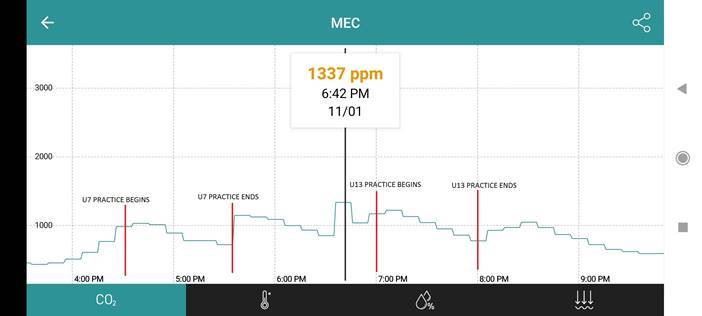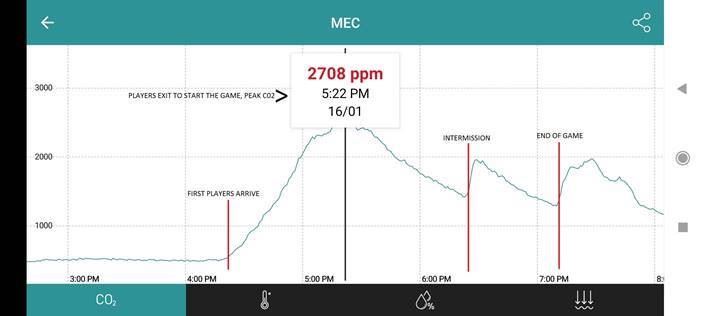Town of Altona Recreation maintenance employee David Sawatzky prepared a report on air quality as a result of recent purchase of a portable air quality monitoring device by the Town of Altona Recreation Services.
See below for this report.
If you have feedback or comments on what your facility is doing to mitigate the issue of airborne transfer or if you have purchased or upgraded air purification devices please send your feedback to Shane at sray@recreationmb.ca and Eric at recreation.manager@altona.ca
Recreation MB would like to thank and acknowledge David Sawatzky for his efforts in preparing the report and Eric Hildebrand for sharing this information and allowing us to share and distribute it.
REPORT
Over the last few weeks we’ve been compiling some data in regards to the CO2 levels in our building. It's been difficult since the activity level in our building has been a bit low since the start of the New Year but we’ve still managed to assess a few key areas.
We’ve spoken with a few different MB HVAC experts and have been told that 800 ppm is the level of CO2 we’re trying to stay below regarding the spread of Covid-19. That said, a short term spike to 1000 ppm, or even 1200 ppm is acceptable assuming a return to normal levels afterwards. Sustained CO2 levels above 1200 ppm indicate a need for better ventilation and levels above 1500 ppm for any sustained period (more than 10 minutes) would indicate a very high chance of Covid spread.
While CO2 levels give a good indication of where air quality needs to be improved each specific area is affected by 2 main factors: how often the space is being used and how many people are using it at that specific time. A few areas of our building have shown to be very well ventilated so far. The Lobby area is not only large, but has enough residual airflow that CO2 levels never pushed past the 800 ppm level while monitoring. The connected rec. offices (main and rec. programmer) also fared well with levels again staying within accepted levels, even when occupied for the entire work day. The Rhineland Pioneer Centre areas, when being used for Pickleball and ballet, have also shown to be ventilated well enough for those particular activities.
The one area of our building that is concerning is the dressing rooms. We've changed our air intake to fresh air only (instead of recycled air) which has improved overall air quality. Unfortunately they're also areas that are unsupervised with prolonged occupancy.
The chart below is from a typical Tuesday evening, Altona Minor Hockey “skills night”. The monitor was in DR #2 (Dressing Room #2) which housed half of the U7 group at 4:30pm and half of the U13 group which started practice at 7:00pm. As you can see CO2 levels were normal (500ppm avg.) prior to any kids arriving and hitting 1000ppm by the time they take the ice. Over the next hour it drops, but only back to 750ppm and when they return, spiking up to 1150ppm. After their practice the room sits empty until the U13 team arrives. But in this empty space the CO2 levels only decrease to about 850ppm. As the U13's get ready for practice the sustained levels are reading 1337ppm. 
While this was a typical evening of practices with smaller groups, a better indication of what full dressing rooms look like is the next example below. January 16th saw a U18 game with the visiting team occupying DR#2 and the air quality monitor. They arrived early, over an hour before game time and CO2 levels spiked quickly, rising from the normal 500ppm and reaching 2708ppm by the time the game started, At these levels Covid-19 spread would almost be unavoidable. After the first 2 periods levels had dropped to around 1400ppm but again, quickly rose during intermission to close to 2000ppm. After the game they again rose to 2000ppm.

There aren't many actions we can take to make our dressing room air quality better. They're interior rooms, unable to access outside air except through the ventilation system. The only real options are reducing occupancy numbers and reducing the amount of time spent inside the and or installing Air Purification units. Back in 2020, before the seasons shut down, we had larger gaps between rentals to accommodate fresh air intake, spacing teams across multiple dressing rooms to reduce the number of occupants. We also had rules regarding entry and exit times for teams, only allowing them to enter the facility 30 minutes prior to a practice/game and exiting immediately after. We had messaged our main users (Altona Minor Hockey) to follow the same protocols this season.
If anyone is curious as to the type of monitor we purchased, the link is available here. https://www.es-canada.com/air-monitoring/46-monitoring-co2-temperature-relative-humidity-and-atmospheric-pressure-aranet4-home.html
As with any Covid related purchase, the receipt is being saved in the hopes that at some point there may be some type of relief program in place for municipalities that have incurred expenses due to Covid.